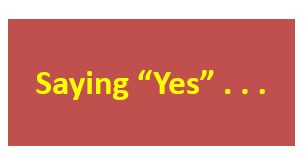It’s easy to say YES. Perhaps too easy.
When the client asks for something – new research, some ad-hoc analysis, an extra workshop – it usually seems like a reasonable request. After all, they pay the bills and shouldn’t they get the most out of their consultants?

When the consultant says YES to a new request, it may feel comfortable and collaborative. The consultant feels like she is doing a good job listening, and the client is happy that his idea was accepted. There is no stress, or pregnant pauses. It is the path of least resistance like water running downhill.
Experienced consultants and lawyers will tell you there are many reasons why being overly agreeable can create problems. Here are four of them.
False promise. It is easy to say YES in the heat of the moment, then completely forget about it. It is the equivalent to a husband telling his wife “sure, honey”, when he was not listening (and definitely not writing things down).
Over promise. It’s a crude graph, but it visualizes what all consultants know to be true: “under-promise, and over-deliver”. When the client asks for 100, promise less (red bar) and deliver more (blue bar). Sad, but true. By lowering client expectations, we have a better chance of exceeding. Call it cynical, call it sandbagging, but it works.
Poor alignment. In my mind, this is the greatest danger. If the client keeps bringing up new ideas and ad-hoc requests. . . AND the consultant keeps agreeing to them . . . something is wrong. It is a symptom of a deeper problem:
Consultant issue
- The project plan is inadequate; key areas that were missing are getting dug up
- The right people were not involved in the beginning; new people keep popping up
- The consultant is doubting her own plan; looking for a life saving ring
Client issue
- The client is not clear what the next steps or is uncomfortable with the timeline
- The analysis has not been robust or poorly explained; the client doubts the numbers
- The client has a pre-defined solution and wants the consultant to rubber stamp it
Thinking through the client’s request
So what is a good way to think about this problem? As you probably already know, consultants love 2×2 matrix. It distills the thinking into 2 variables, and forces you to think through the problem. Here is my take on the situation.
1. Say Yes: If the request is minor and useful – don’t think twice – say yes and get it done. Professionally and quickly. Add value and move on. The client’s suggestion was helpful.
2. Look for alternatives. If the request will take a lot of time and is relevant to the project, look for a simpler and more elegant solution. Ask questions and understand WHY the client has this new request. One time, I resolved a client’s concern simply by adding a short footnote at the bottom of a PowerPoint presentation.
3. Offer to look into it. If the request is not relevant to the project, it can be a good opportunity to sell more consulting work. Offer to explore the issue – perhaps run a bit of analysis, or do some research – nothing serious, just some sleuthing on the topic.
4. Sell more work. Provided there is budget, this could easily be the easiest way to sell new work. It could be a blossoming client-consultant relationship where each project is followed by another one. Nothing sells work like doing good work. I would suggest 20% of work is sold this way.
Finding a smarter way to say NO. Any long-married husband will tell you that saying NO directly to your wife’s request is neither efficient nor effective way to build a relationship. Same is true with clients. No consultant got new business by telling her client NO to his face. Find out the reasons WHY the client is asking the new questions. It might be scope creep, but it could just as easily be something you can solve quickly, or even sell more consulting work.
PS: Wrote this post 5 years ago – since then, it was translated into Japanese for an executive recruiting firm below. Also a few other thoughts on this topic:
1) Are you thinking far enough in advance? If you continuously get new requests, this may mean that you are not thinking ahead. Meta-cognition – thinking 1 move ahead of your manager, and 2-3 moves ahead of the client.
2) You need to understand WHY the client is asking you for the new request. Do they lack the confidence in your analysis? Are they getting push back? Get to the root cause of the angst and solve it together.
3) There is some trust. It’s good that the client is communicating. Much better to ask you for a favor, than tell their boss (or your boss), that something is lacking.
4) Did you forget? Nothing is more frustrating than a consultant who “acts” like they are listening, but forget to follow through with client’s requests. Is this something they requested once before? And. You. Forgot?
5) Get buy-in on the approach. Don’t assume your client understands your approach after seeing it once during the kick-off meeting. Reiterate it during update meetings and at milestones. If they cannot explain it to their cousin, you did a crappy job of educating them.
6) Give the client something to do. Yes, make it easy for your client to succeed and look good, but also give them something meaningful to do. You don’t want a client to feel that their contribution is to merely “pile on” requests or continually critique the approach. Don’t turn them into a critic.
What other tips / tricks / war stories do you have on saying YES smartly, or creatively finding other non-Yes solutions?
Related Posts:
